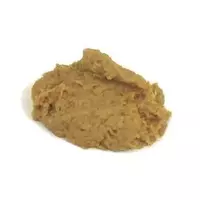Curry pasta

Curry pasta is an integral flavor base in the form of a spice mixture of the same name Thai cuisine. This product differs from the Indian original in its consistency. So, in India it is a dry powder, while Thai curry paste looks like a spicy wet paste.
It is noteworthy that throughout Thailand there are a great many varieties of curry paste and in each province this dish is prepared in its own way. However, despite all these differences, curry paste has one thing in common - the main composition of the product. In particular, this paste, which is distinguished in the middle six species (let's talk about them later), necessarily includes such components as: dried red chili, lemongrass or lemon sorghum, galangal, kafir lime zest, garlic, shallots, shrimp paste, root celery, cumin.
The first three varieties of this fragrant spice, considered the most popular and sought after, are green, red and yellow curry pasta. Green curry paste is characterized by medium spiciness and little acidic content through the use of lime zest. It is great for a variety of fish and seafood-based dishes.
The second place rightfully belongs to red pasta, the taste of which can be described as very spicy. And this is even despite the presence of coconut milk in the composition. Red paste is used mainly in the preparation of chicken, beef, pork, seafood and even frog legs.
The yellow curry paste tastes closest to its Indian original. It is distinguished by its dense and delicate creamy taste, thanks to the addition of not only coconut milk to the composition of this product, but also coconut cream with palm sugar. Usually chicken, duck, potatoes and other vegetables are prepared with yellow curry.
The other three curry pastes are considered subspecies of red seasoning, but they also have their own features. For example, Penang curry paste is less spicy and thicker than traditional Thai red. The classic ingredients for Penang curry are seafood or shredded beef in thick coconut sauce.
The sour curry paste differs in light red. It is customary to cook liquid spicy curry soup from seafood, fish or vegetables with it. The main difference between sour curry paste and the rest is the complete absence of coconut milk in the finished dish.
The latter variety includes the dark red Massaman curry paste, which contains not entirely Thai spices - cardamom, cloves, cinnamon and badyan. Most often, beef is prepared with it, much less often duck, chicken or tofu.
251 kCal curry pastes
Energy value of curry paste (Ratio of proteins, fats, carbohydrates - ju):
Proteins: 3.5 g (~ 14 kCal)
Fats: 19 g. (~ 171 kCal)
Carbohydrates: 15g (~ 60kCal)
Energy ratio (bj | y): 6% | 68% | 24%
 Español
Español Français
Français Português
Português Русский
Русский 简体中文
简体中文 繁體中文
繁體中文 日本語
日本語 한국어
한국어 العربية
العربية Türkçe
Türkçe Қазақ
Қазақ Deutsch
Deutsch Italiano
Italiano Українська
Українська
